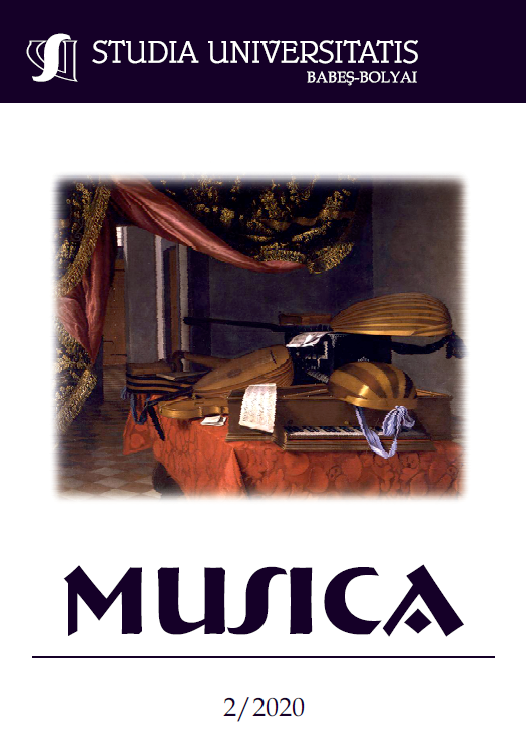THE NYÍREGYHÁZA MODEL: THE TEACHING OF TEACHING MUSIC / OF MAKING MUSIC
DOI:
https://doi.org/10.24193/subbmusica.2020.2.01Keywords:
digital education material, folk music, children’s songs, graphic notation, generativity.Abstract
The Music Pedagogy Workshop working within the Institute of Music at the University of Nyíregyháza has initiated several programmes related to music methodology, financed by EU funds. Within the framework of subproject entitled “Renewing the practice of teaching music in public education based on folk traditions,” digital handbooks and teachers’ books have been designed for the Grades 1 to 4 of primary schools. The present paper introduces the novel features of the material designed for Grades 1 and 2. It touches upon the issues of the relevant points in curricular regulations, the possibilities of the innovative methods of score notation and score reading, tailored to the age characteristics of students, and the new approach to teaching the musical elements connected to a selected song corpus. The basic concept in designing the material of the first two grades was the amalgamation of folk culture, including folk tales and children’s game songs, and the world around children. The elements of the knowledge of the present and the past appear side by side in the individual thematic units. Interdisciplinarity also gets emphasised. The generative and creative music activities, the tasks aimed at developing receptive competences, games, and the application of graphic notation, targeting the development of fine motor skills and music literacy, have been designed to broaden the toolkit of music pedagogy for junior schools.References
Nat (2012): 110/2012. (VI. 4.) Kormányrendelet a Nemzeti alaptanterv kiadásáról, bevezetéséről és alkalmazásáról. [National Curriculum], Magyar Közlöny, 2012. 66. pp.10784-10790. https://magyarkozlony.hu/dokumentumok/f8260c6149a4ab7ff14dea4fd427f10a7dc972f8/megtekintes accessed: 03 08 2020.
Nat (2020): 5/2020. (I. 31.) Kormányrendelet a Nemzeti alaptanterv kiadásáról, bevezetéséről és alkalmazásáról szóló 110/2012. (VI. 4.) Korm. rendelet módosításáról. [National Curriculum], Magyar Közlöny, 2020. 17. pp. 406-412. https://magyarkozlony.hu/dokumentumok/3288b6548a740b9c8daf918a399a0bed1985db0f/megtekintes accessed: 03 08 2020.
Kerettanterv (2012): 51/2012. (XII. 21.) számú EMMI rendelet 1. melléklete. Kerettanterv az általános iskola 1-4. évfolyamára, Ének-zene B. [Framework Curriculum for Grades 1-4 of Primary Schools, Music, Version B] https://kerettanterv.oh.gov.hu/01_melleklet_1-4/index_alt_isk_also.html accessed: 03 08 2020.
Kerettanterv (2020): A 2020-as NAT-hoz illeszkedő tartalmi szabályozók. [Framework Curriculum for Grades 1-4 of Primary Schools] https://www.oktatas.hu/kozneveles/kerettantervek/2020_nat accessed: 03 08 2020.
Ádám Jenő: Módszeres énektanítás [Systematic Singing Training], Országos Közoktatási Tanács, Budapest, 1944.
Burián Miklós: Miért nem szeretik a gyerekek az ének-zene órát? [Why do children dislike Music classes?], in: Új Pedagógiai Szemle, 62. 4-6. pp. 165-174. http://epa.oszk.hu/00000/00035/00152/pdf/EPA00035_upsz_2012_04-06_165-174.pdf accessed: 08 02 2020.
Csató Mónika: NYISS ÉS LÁSS! (2.) ÉS… még mindig: az énekórákról [OPEN UP AND SEE (2) AND... Once Again on Music Lessons], in: Parlando 2015/4. http://www.parlando.hu/2015/2015-4/CsatoMonika-Nyiss.htm accessed: 18 01 2020.
Csató Mónika: PARADIGMÁK HARCA, MŰFAJOK HARCA. Még mindig az ének-zene tanítás vitájáról [THE WAR OF PARADIGMS, THE WAR OF GENRES. Still About the Debate on Teaching Music], in: Parlando 2015/5. http://www.parlando.hu/2015/2015-5/CsatoMonika.htm accessed: 18 01 2020.
Csengery Kristóf: Az iskolai zeneoktatás válsága [On the Crisis of Teaching Music in Schools], ZENE-kar, 2014/2. https://zene-kar.hu/wp-content/uploads/2017/12/zenekar_2014_2_web.pdf accessed: 20 01 2020.
Dohány Gabriella: Zenei élmény az énekórán? [Musical experience in Music Lessons?], in: Parlando 2017/3. https://www.parlando.hu/2017/2017-3/DohanyGabriella.pdf accessed: 20 01 2020.
Dr. Benedek Mónika: Improvizációs koncepciók az előadói gyakorlatban és a zenepedagógiában [Concepts on Improvisation in Performing Practice and in Music Pedagogy], in: Parlando 2018/6. https://www.parlando.hu/2018/2018-6/Benedek_Monika-Improvizacio.htm accessed: 03 08 2020.
Dr. habil. Vas Bence (szerk.): Zenepedagógia tankönyv [Texbook on Music Pedagogy], Pécsi Tudományegyetem Művészeti Kar Zeneművészeti Intézet, Pécs, 2015. http://www.art.pte.hu/sites/www.art.pte.hu/files/files/menuk/dokument/tudomany/innovacio/zmi/zenepedagogia_vegleges.pdf accessed: 15 12 2019.
Hülber László – Lévai Dóra – Ollé János: Út az új generációs digitális tankönyvek megvalósításához [A Pathway to the Implementation of New Generation Digital Textbooks], in: Könyv és Nevelés 2015/1. https://folyoiratok.oh.gov.hu/konyv-es-neveles/ut-az-uj-generacios-digitalis-tankonyvek-megvalositasahoz accessed: 10 02 2020.
Jakobicz Dorottya – Wamzer Gabriella – Józsa Krisztián: Motiválás az ének-zene órákon [Motivation in Music Lessons], in: Gyermeknevelés. 2018/2. pp. 18-31. http://ojs.elte.hu/gyermekneveles/issue/view/42/25 accessed: 13 08 2020.
Janurik Márta: Hogyan viszonyulnak az általános és középiskolás tanulók a klasszikus zenéhez? [How do Primary and Secondary School Students Approach Classical Music?], in: Új Pedagógiai Szemle, 2009/5. 47–64. https://folyoiratok.oh.gov.hu/sites/default/files/article_attachments/upsz_2009_7_04.pdf accessed: 20 01 2020.
Janurik Márta: Az ének-zene oktatás megújulásának lehetőségei [Chances of the Renewal of Teaching Music], in: Magyar Tudomány, 2018/6. https://mersz.hu/hivatkozas/matud_irod_2018_06_7943#matud_irod_2018_06_7943 accessed: 20 01 2020.
Kárpáti Andrea: FIRKÁK, FORMÁK, FIGURÁK – a vizuális nyelv fejlődése a kisgyermekkortól a serdülőkorig [SCRIBBLES, FORMS, FIGURES: The Development of Visual Language from Infancy to Adolescence], 2001. https://docplayer.hu/793460-Firkak-formak-figurak-a-vizualis-nyelv-fejlodese-a-kisgyermekkortol-a-serdulokorig-karpati-andrea.html accessed: 11 02 2020.
Kerékfy Márton (szerk.): Ligeti György válogatott írásai [Selected Writing of György Ligeti], Rózsavölgyi és Társa, Budapest, 2010.
Kodály Zoltán: 100 éves terv [A 100-year Plan], in: Énekszó, 1947. XIV. évf. 79/1–2.
Kodály Zoltán (szerk.): Iskolai énekgyűjtemény I-II. [School Songbook I-II.], (Közreműködött: Kerényi György), Országos Közoktatási Tanács, Budapest, 1943.
L. Nagy Katalin: Zenei nevelés – 2000: kihívások előtt az ezredforduló zenetanítása [Music Education – 2000: The Challenges of Teaching Music at the Millennium], in: Iskolakultúra, 1996/12, pp. 3-11. http://www.iskolakultura.hu/index.php/iskolakultura/article/view/31455/31172 accessed: 11 02 2020.
Löblin Judit: A hangjegyírás a kezdetektől a tipográfiáig [The History of Notation from the Beginnings to Typography], OSZK, 1982. https://mek.oszk.hu/00200/00207/html/ accessed: 11 02 2020.
Sárosi Bálint: Vokális zene [Vocal Music], in: Magyarország a XX. században. III. kötet. Babits Kiadó, Szekszárd, 1996-2000. p. 561. http://vmek.niif.hu/02100/02185/html/556.html accessed: 13 08 2020.
Downloads
Published
How to Cite
Issue
Section
License
Copyright (c) 2020 Studia Universitatis Babeș-Bolyai Musica

This work is licensed under a Creative Commons Attribution-NonCommercial-NoDerivatives 4.0 International License.



